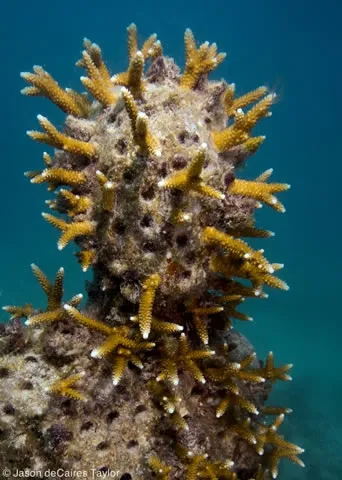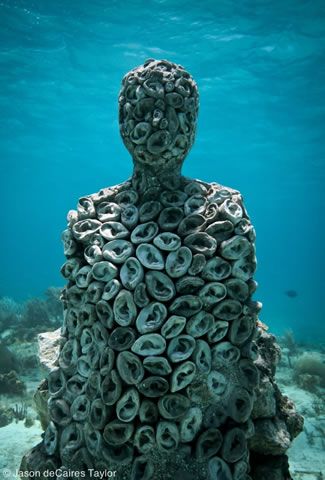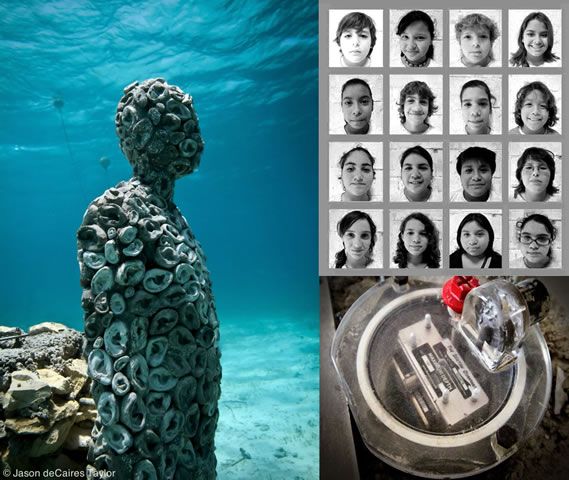All Ears! An Underwater Sculpture that Listens
A collaboration between sculptor Jason deCaires Taylor and marine biologist Heather Spence aims to track the development of a new coral reef
/https://tf-cmsv2-smithsonianmag-media.s3.amazonaws.com/filer/20120911095004The-Listener-web.jpg)
Since 2009, artist Jason deCaires Taylor has submerged nearly 500 statues off the coast of Cancún. Located within Mexico’s National Marine Park, his undersea gallery includes still lifes and human figures resting in “ghostly repose,” as a recent New York Times article so eloquently describes.
Some 750,000 people visit the marine protected area each year, and many snorkelers and divers make a point to swim through Taylor’s stunning Museo Subacuático de Arte, just 15 minutes by boat from the coast. After all, as Taylor touts on his personal Web site, his sunken sculpture park is “one of the largest and most ambitious underwater artificial art attractions in the world.”

Inextricably entwined in the art is science. The sculptures are intentionally placed just off of the Mesoamerican Reef. “The idea is that the sculptures detract visitors from the natural reef and reduce some of the pressure on it,” says Taylor. His artwork, at the same time, provides a solid structure for reef building. The sculptures are made of a strong, marine-grade cement that is pH neutral and attractive to corals, sponges and tunicates; they also have holes and crevices where sea creatures can hide.
This early in the experiment, it is hard to tell whether the art installation is an effective conservation tool. Some scientists argue that planting manmade sculptures on the sea floor is too disruptive to ecosystems to be beneficial, while others, who see more pros than cons, estimate that coral will grow and completely disguise the figurines within a decade.
Taylor, an experienced diver and underwater photographer, routinely photographs his sculptures to record any changes. But, with his sculpture count climbing by the hundreds, Taylor admits it is becoming increasingly difficult to monitor them all.
Heather Spence, a marine biologist and doctoral student at Hunter College in New York City, met Taylor two years ago, while doing field work in Cancún. She and Taylor got to talking about how they could scientifically document changes, such as the arrival of new species, to the museum site over time. “I was like, why don’t we track the changes acoustically?” says Spence.
An accomplished cello and viola de gamba player, Spence has a real interest in bioacoustics. She suggested attaching hydrophones to some of Taylor’s existing sculptures. The artist, however, thought it would be nicer to build an entirely new sculpture around the concept. “We decided to make ‘The Listener,’” says Taylor.

“The Listener” is a life-sized human figure covered in ears. Taylor invited a group of schoolchildren, ages eight to 12, from Cancún to his studio for a workshop. He taught them how to make casts of people, and, in turn, the students volunteered to have models made of their ears. For two years on and off, Taylor worked on “The Listener.” In late May, the sculpture was deployed in water about 13 feet deep at the museum site at Punta Nizuc. Inside, Spence installed an ecological acoustic recorder, jointly developed by the University of Hawaii and the National Oceanic and Atmospheric Administration; it has been recording 30-second clips every 15 minutes since then.
“This particular experiment is giving us a chance to track the development of a new reef. As things start to grow on the sculpture, and this artificial reef develops, we can track it acoustically,” says Spence. “That has never been done before.”
Spence plans to retrieve the first set of sound data from the recorder’s internal hard drive this fall, most likely in October. “Part of something so new is that you don’t know what you are going to find,” she says. Spence will start by listening to some random samples to get an overall picture of how the recording system is working and what kinds of sounds it is picking up. Then, she will listen for particular species and track patterns over time.
Spence credits her musically trained ear for her ability to match sounds to organisms. Snapping shrimp, and maybe lobsters, she says, should be key players. In some cases, Spence can identify the noisemaker down to the species level. “When there is enough data, you know what that particular call of a species relates to,” she says. There has been research done on damselfish mating calls, for instance. “If you hear that call, you know that there are not only damselfish in the area, but they are spawning. You can actually get pretty detailed information from the sounds,” Spence says.
Taylor is already brainstorming how his artwork, which informs science, can re-inform art. “I am very interested in doing something with the sound data,” he says. Perhaps a film.

/https://tf-cmsv2-smithsonianmag-media.s3.amazonaws.com/accounts/headshot/megan.png)
/https://tf-cmsv2-smithsonianmag-media.s3.amazonaws.com/accounts/headshot/megan.png)